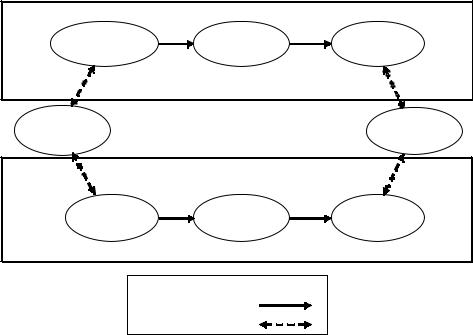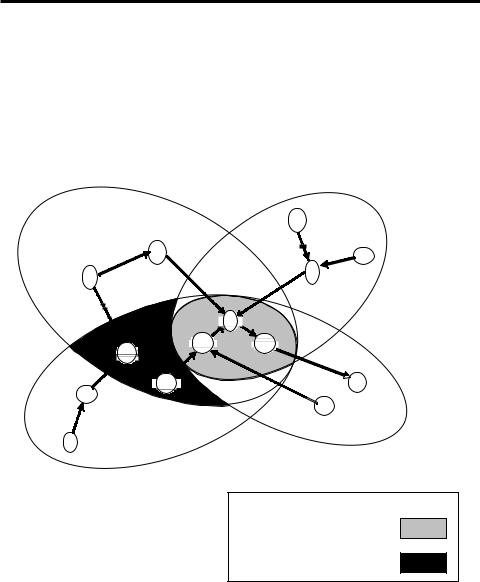
Narayanan V.K., Armstrong D.J. - Causal Mapping for Research in Information Technology (2005)(en)
.pdf340 Iandoli and Zollo
Pfleeger, S.L. (1999). Understanding and improving technology transfer in software engineering. Journal of Systems and Software, 47, 11-124.
Pressman, R.S. (2000). Software engineering: A practitioner’s approach, 5th edition. New York: McGraw-Hill.
Putnam, L., & Myers, W. (1992). Measures for excellence. New York: Yourdon Press.
Quinn, R.E., and Cameron, K.S. (1983). Organizational life cycles and shifting criteria and effectiveness. Management Science, 9, 33-51.
Riemenshneider C.K., Hardgrave, B.C., & Davis, F.D. (2002). Explaining software developer acceptance of methodologies: a comparison of five theoretical models. IEEE Transactions on Software engineering, 12, 1135-1145.
Schank, R.C. (1986). Explanation patterns: Understanding mechanically and creatively. Hillsdale, NJ: Lawrence Erlbaum.
Schank, R.C., & Abelson, R.P. (1977). Scripts, plans, goals and understanding, an inquiry into human knowledge structures. Hillsdale, NJ: Lawrence Erlbaum.
Schreiber et al. (2000). Knowledge engineering and management. The CommonKADS methodology. Cambridge, MA: MIT Press.
Simon, H.A. (1961). Administrative behavior (2nd ed.). New York: Macmillan. Thagard, P. (1992). Conceptual revolution. Princeton, NJ: University Press.
Thompson, R.W., Higgins, C.A., & Howell, J.M. (1991). Personal computing: Toward a conceptual model of utilization. Management Information Systems Quarterly, 15(1),125-134.
Tversky, A., & Kahneman, D. (1974). Judgement under uncertainty. Heuristics and Biases, Science, 185, 1124-1131.
Von Neumann, J., & Morgestern, O. (1953). Theory of games and economic behavior, Princeton, NJ: Princeton University Press.
Walsh J.P., & Ungson, G.R. (1991). Organizational memory. Academy of Management Review, 1, 57-91.
Weick, K.E. (1976). The social psychology of organization, 2nd edition. Reading, MA: Addison Wesley.
Wrightson, M.T. (1976). Documentary coding method. In Axelrod, R. (Ed.), Structure of decisions: The cognitive maps of political elites. Princeton, NJ: Princeton University Press.
Yourdon, E. (1988). Managing the system life cycle. Englewood Cliffs, NJ: Prentice-Hall.
Zadeh, L. (1973). Outline of a new approach to the analysis of complex systems and decision processes. IEEE Transactions on Systems, Man and Cybernetics, 35-48.
Zollo, G. (1998). Cognition, words and logic: How fuzzy logic can help us to design new organizational procedures. Accepted for presentation at the Academy of Management Meeting, San Diego, August.
Copyright © 2005, Idea Group Inc. Copying or distributing in print or electronic forms without written permission of Idea Group Inc. is prohibited.

Knowledge at Work in Software Devlopment 341
Appendix
Table for the Selection of Life-Cycle
CommercialOff theShelf Software |
Excellent |
PoortoExcellent |
PoortoExcellent |
N/A |
N/A |
Excellent |
Excellent |
Poor |
N/A |
N/A |
Fair |
|
|
|
|
|
|
|
|
|
|
|
|
Design-to- Tools |
Fair |
Poorto Excellent |
Poorto Excellent |
Poor |
Poorto Fair |
Excellent |
Fairto Excellent |
Excellent |
Excellent |
Excellent |
Fair |
|
|
|
|
|
|
|
|
|
|
|
|
Design-to- Schedule |
PoortoFair |
Poor |
Fair |
Fairto Excellent |
Fairto Excellent |
Excellent |
Fair |
PoortoFair |
Fair |
Excellent |
Poor |
|
|
|
|
|
|
|
|
|
|
|
|
Evolutio nary Delivery |
Fairto Excellent |
Poor |
Fairto Excellent |
Excellent |
Fair |
Fair |
Fair |
Fairto Excellent |
Excellent |
Excellent |
Fair |
|
|
|
|
|
|
|
|
|
|
|
|
Staged Delivery |
Poor |
Poor |
Excellent |
Excellent |
Fair |
Fair |
Fair |
Poor |
Fair |
Excellent |
Fair |
|
|
|
|
|
|
|
|
|
|
|
|
Evolutionary Prototyping |
Excellent |
PoortoFair |
Fair |
Excellent |
Fair |
Poor |
Fair |
Excellent |
Excellent |
Fair |
Poor |
|
|
|
|
|
|
|
|
|
|
|
|
Modified Waterfall |
Fairto Excellent |
Fairto Excellent |
Excellent |
Excellent |
Fair |
Fair |
Excellent |
Fair |
Fair |
Fairto Excellent |
Poorto Fair |
|
|
|
|
|
|
|
|
|
|
|
|
Spiral model |
Excellent |
Excellent |
Excellent |
Excellent |
Excellent |
Fair |
Fair |
Fair |
Excellent |
Excellent |
Poor |
|
|
|
|
|
|
|
|
|
|
|
|
Code&fix |
Poor |
Poor |
Poor |
Poorto Fair |
Poor |
Poor |
Excellent |
Poorto Excellent |
Fair |
Poor |
Excellent |
|
|
|
|
|
|
|
|
|
|
|
|
Pure Waterfall |
Poor |
Poor |
Excellent |
Excellent |
Poor |
Fair |
Poor |
Poor |
Poor |
Fair |
Fair |
|
|
|
|
|
|
|
|
|
|
|
|
Lifecyclemodel capability |
Workswithpoorly understood requirements |
Workswithpoorly understood architecture |
Produceshighly reliablesystems |
Producessystem withlargegrowth envelope |
Managesrisks |
Canbeconstrained toapredefined schedule |
Haslowoverhead |
Allowsfor midcourse corrections |
Providescustomer withprogress visibility |
Provides managementwith progressvisibility |
Requireslittle manageror developer sophistication |
|
|
|
|
|
|
|
|
|
|
|
|
Adapted from McConnell (1996)
Copyright © 2005, Idea Group Inc. Copying or distributing in print or electronic forms without written permission of Idea Group Inc. is prohibited.
342 Iandoli and Zollo
Section IV
Potential Directions
Copyright © 2005, Idea Group Inc. Copying or distributing in print or electronic forms without written permission of Idea Group Inc. is prohibited.

Object-Oriented Approaches to Causal Mapping 343
Chapter XIV
Object-Oriented Approaches to Causal Mapping:
A Proposal
Robert F. Otondo
The University of Memphis, USA
Abstract
Comparing, contrasting, and collectivizing causal maps provides a useful way for extending representations of individual-level cognitions to an organization-level of analysis. Carrying out these processes can be tricky, however, because the terms used to denote nodes within causal maps are often so terse that important nuances and meanings critical to linking or distinguishing the espoused beliefs of multiple individuals may not be faithfully represented. Previous efforts in causal map research are extended by representing these linguistic and semantic nuances in associative, categorical, or other cognitive maps, then using those maps to link related elements of causal maps. These multiple types of cognitive maps are then integrated in a logical view (i.e., class and object structures) of a graph-theoretic, object-oriented design.
Introduction
Causal maps represent the network of causal relations embedded in an individual’s explicit statements, and as such provide an explicit representation of the deep-rooted cognitive maps of individuals (Huff, 1990; Nelson, Nadkarni, Narayanan & Ghods, 2000).
Copyright © 2005, Idea Group Inc. Copying or distributing in print or electronic forms without written permission of Idea Group Inc. is prohibited.

344 Otondo
While causal maps provide a concise representation of an individual’s beliefs and assumptions about causality, that conciseness often fails to represent important nuances in complex beliefs and assumptions that are crucial to extending individual causal maps to an organization-level of analysis. These nuances in word use can lead to the same term being used to represent different ideas, different terms being used to represent similar ideas, or a host of words changing and emerging within a vocabulary over time as individuals share beliefs. These patterns of word use create difficulties in the comparison of individual causal maps, and suggest that while a causal map may be sufficiently “rich” to represent causal beliefs at the individual level of analysis, collections of individual causal maps do not adequately represent the richness of the problem space of social causal cognition.
The purpose of this chapter is to provide frameworks for representing important nuances in language use during social causal cognition, and to embed those frameworks in groupand organization-level causal maps. These goals will be accomplished through two objectives. First, an overall strategy for mitigating the representational limitations of causal maps will be presented. This strategy augments collections of causal maps with other representations of the cognitive, communicative, and behavioral aspects of knowledge sharing. This family of representations, collectively called cognitive maps, is a general class of physical representations of thoughts and beliefs that can represent individual assertions, or those elicited from a group (Huff, 1990; Montazemi & Conrath, 1986). Cognitive maps can provide a rich resource for comparing, contrasting, or collectivizing large numbers of causal maps. Causal maps are only one sub-class of cognitive maps. Other sub-classes of cognitive maps include such representations as categorical maps that focus on relationships of similarity and associative maps that represent frequencies and changes in word use (Huff, 1990).
The second objective of the chapter is to provide a design for a tool that can seamlessly acquire, store, and manipulate multiple cognitive maps. This is a tall order because augmenting causal maps with various types of cognitive maps would significantly increase the computational complexity of processing causal maps. Computer-based information systems are a likely candidate for this tool because they have been successfully used in the past for problem spaces of similar complexity.
The chapter is organized as follows. First, difficulties of using causal maps at the social level of analysis are examined. Second, alternative high-level designs for a computerbased tool that are commensurate to the characteristics of cognitive mapping are proposed and discussed. This discussion is then extended to a more detailed description of data and functional elements necessary for the proposed computer-based tool. Finally, conclusions, limitations, and potential applications are discussed.
Representing Causal Beliefs at Social
Levels of Analysis
Causal maps were originally designed to represent an individual’s beliefs about causal relationships between entities in the real world. There are several reasons why these
Copyright © 2005, Idea Group Inc. Copying or distributing in print or electronic forms without written permission of Idea Group Inc. is prohibited.

Object-Oriented Approaches to Causal Mapping 345
representations of individual cognition might contribute to our understanding of social cognition. Perhaps the simplest reason is that a comparison of causal maps from different individuals is useful for identifying similarities and differences in causal beliefs from across an organization, thus providing measures of an organization’s cognitive homogeneity (Laukkanen, 1994). Causal maps are also useful for documenting changes in coworkers’ causal beliefs over time, therefore providing a means for analyzing the processes of belief sharing and organizational learning (Langfield-Smith, 1992). A third reason lies in the hope of identifying feedback loops and organization-wide effects, which could help mitigate “vicious circles” and unintended effects (Morecroft, 1988; Senge, 1990; Senge & Sterman, 1992; Eden, Ackermann & Cropper, 1992). These various processes for using individual causal maps to represent and understand social causal cognition are called, for the purposes of this chapter, social causal mapping.
Social Causal Mapping Across Diverse Vocabularies
While comparing, contrasting, and collectivizing causal maps can play important roles in understanding social cognition, these processes are often problematic because the terms, words, and phrases elicited from subjects revealing their causal beliefs can be difficult to match. Unlike the systems dynamics models of engineered physical systems that reflect modules interconnected via well-defined interfaces described in more-or-less standardized nomenclatures (e.g., Forrester, 1961), collections of causal maps are representations of individual cognitive belief systems that typically reflect a wide variety of experiential, cultural, contextual, and procedural knowledge domains and related vocabularies. This complexity is especially evident in knowledge management systems, and is embodied within Davenport and Prusak’s (1998) differentiation of knowledge (i.e., “a fluid mix of framed experience, values, contextual information, and expert insight that provides a framework for evaluating and incorporating new experiences and information” from data (i.e., “a set of discrete, objective facts about events”) and information (i.e., data that “informs,” that “makes a difference”). These differences, Davenport and Prusak argue, require that knowledge management projects encompass a wider set of behavioral factors, including the motivation of trust, communication, encouragement, and rewards.
Comparing, contrasting, and collectivizing diverse causal maps under these circumstances is typically complex, especially when the terms used in the nodes of causal maps are terse distillations of complex beliefs. Past research has usually addressed this complexity in one of two ways. One approach unifies the interpretations and terms embedded within causal maps into a “standard” vocabulary in which one word is chosen to represent a group or category of synonyms. An example of this approach is displayed in Figure 1. That example is based on the ways an organization can mitigate risk, and expanded into how those perceptions might be conceptualized and asserted by two individuals. Such mental concepts are represented as nodes, which typically bear the name of that item or concept (e.g., “risk” and “loss of data”). Causal relationships between nodes are represented by solid arcs in which the node at the “tail” of the arc is a determinant of the node at the “head” of the arc. Arcs representing causal relationships are typically valued as “+” or “-” to denote whether the arc represents a directly or inversely proportional relationship, respectively. Arcs representing categorical relation-
Copyright © 2005, Idea Group Inc. Copying or distributing in print or electronic forms without written permission of Idea Group Inc. is prohibited.

346 Otondo
Figure 1. Integrated causal and categorial maps
“acceptable IS |
— |
litigation |
+ |
settlement |
use” training |
|
|
costs |
|
|
|
|
||
|
|
Individual “A” |
|
|
IS security |
|
|
|
risk |
procedures |
|
|
|
|
|
|
|
|
|
|
|
Individual “B” |
|
|
updating |
— |
damage |
+ |
loss of data |
firewalls |
|
from |
|
|
|
|
|
||
|
|
Legend |
|
|
Causal relationship
Categorical relationship
ships do not need plus and minus signs. For the purposes of this chapter, categorical relationships are represented by two-headed dashed arcs (!" ) that signify the nodes so linked are co-members of a set of synonyms. Figure 1 contains two sets of synonymous terms: one set refers to hazards of organizational life (i.e., risk, settlement costs, and loss of data), while the other refers to the protection of information systems (IS) (i.e., IS security procedures, “acceptable IS use” training, and updating firewalls).
Another method for comparing, contrasting, and collectivizing diverse causal beliefs relies on multiple group interview sessions. In this approach, all participants meet together at one or more times, and one or more collective causal maps are drawn up to represent the “products of [their] collective cognitions” (Langfield-Smith, 1992). Thus, a collective causal map can document single or multiple group interviews. The degree of shared beliefs is often represented with dotted and hatched areas (Figure 2). Causal beliefs elicited from individuals within these group meetings can be conceptualized as sets, in which each individual’s causal map is represented as a distinct set. Each individual causal map is then represented within a circle of a Venn diagram. Shared beliefs among group participants are represented as intersections between the circles of individual causal map sets (Figure 2). Multiple collective causal maps, each documenting one group session, can show changes in the use and understanding of specific terms as well as in general levels of shared beliefs. This approach to collective causal mapping places the responsibility of establishing word meanings on participants, not researchers.
Copyright © 2005, Idea Group Inc. Copying or distributing in print or electronic forms without written permission of Idea Group Inc. is prohibited.

Object-Oriented Approaches to Causal Mapping 347
Another approach to collectivizing raw individual maps relies upon generalized terms, typically drawn from academic theory or disciplines, as a basis for interpreting and/or translating idiosyncratic causal assertions into a common language (e.g., Narayanan & Fahey, 1990; Laukkanen, 1994). While useful, such references and interpretations should be recorded to maintain the integrity of the original causal assertions and to document interpretation, translation, and learning processes over time.
Representing Diverse Vocabularies in Social Causal
Mapping
Unfortunately, these approaches have suffered from shortcomings in the representational powers of causal maps. That is, causal maps may be “good enough” to represent causal beliefs at the individual level of analysis, but they have significant limitations in representing the linguistic and temporal aspects of the underlying beliefs, knowledge, and learning processes that play important roles in collectivizing large numbers of causal
Figure 2. Collective beliefs (extended from Langfield-Smith, 1994:328)
C |
a |
A |
|
|
|
|
g |
b |
|
|
|
|
f |
c |
|
|
j |
i
D
h
m |
l |
k |
n |
 e
e


 d B
d B
Legend
Beliefs shared by A, B, C, and D
Beliefs shared by C and D only
Copyright © 2005, Idea Group Inc. Copying or distributing in print or electronic forms without written permission of Idea Group Inc. is prohibited.
348 Otondo
maps at the group and organization levels of analysis. One limitation results from individuals who use different terms for the same concept (i.e., synonyms). Another limitation results from the use of the same term for different concepts (i.e., connotations). Such differences have been found to lead to disagreements over appropriate descriptions of particular ideas. Similar difficulties arise when individuals have not developed “a sufficiently comprehensive body of shared language” or cannot agree on “the most appropriate language with which to describe a particular idea” (Langfield-Smith, 1992). Moreover, these concepts and word uses may change over time as the individuals learn about the environment around them, presenting additional difficulties in relating causal maps elicited across long periods of time. The nuances of human language and thought and the idiosyncrasies in the styles and rates of individual learning make it difficult to compare the causal assertions of multiple individuals over time and thus construct collective causal maps (Langfield-Smith, 1992).
Linguistic, learning, and other social phenomena may not be properly considered when causal maps are simply linked together. That approach treats node and arc elements as (in the words of Boland, Tenkasi & Te’eni, 1994) “unproblematic, predefined, and prepackaged” rather than “subjective” and “interpretive,” and ignores the need to “provide the conditions for surfacing and challenging important assumptions…, for complicating their thinking…and for enabling significant change when it is required.” To adequately represent the linguistic and learning dimensions of the social causal reasoning problem space, collections of causal maps should exhibit characteristics of “good” representations. “Good” representations exhibit the following characteristics (Winston, 1984):
1.“make the important things explicit”
2.“expose natural constraints, facilitating some class of computations”
3.“are complete…[they] say all that needs to be said [about the problem space at hand]”
4.“are concise”
5.“are transparent” (i.e., easy for users to understand)
6.“facilitate computation…[they] can store and retrieve information rapidly”
7.“suppress details” unless requested
8.“are computable by an existing process”
Causal maps exhibit many of these aspects in representing individual causal reasoning. They are explicit, concise, and relatively transparent. However, they are not so good at representing social causal reasoning. They do not explicitly reveal nuances in human language and cognition, which are important considerations in the social construction of meaning. It is also difficult to represent opposing views of causality within a single causal map. This means that a single causal map cannot represent this important feature of social learning. This limitation also limits the computational power of causal maps in understanding multiple node-arc-node segments or feedback loops (i.e., multiple node-
Copyright © 2005, Idea Group Inc. Copying or distributing in print or electronic forms without written permission of Idea Group Inc. is prohibited.

Object-Oriented Approaches to Causal Mapping 349
arc-node segments that form a chain that returns to the point of origin, thus creating a “loop”).
Fortunately, there are other types of cognitive maps that more fully represent the linguistic, temporal, and conceptual dimensions of the problem space of social causal cognition. Again, the term cognitive map refers to a general class of maps that represent cognition, understanding, and beliefs, of which causal maps are only one type. Other types of cognitive maps that can assist in social causal mapping include categorical cognitive maps showing how concepts and words are related linguistically across vocabularies and knowledge domains. Associative maps describe patterns of word use, such as those found through content analysis. Argument cognitive maps represent an individual’s assumptions, evidence, and reasons that underlie beliefs. Collections of cognitive maps are thus better able to meet the requirements of “good” representations.
Long-term collections of categorical, associative, and other cognitive maps can facilitate deeper insight into how organization members reason and develop patterns of causal belief over time, and provide important tools for making the representation of social causal thinking more complete. Thus, collections of cognitive maps are better though nonetheless imperfect representations of the problem space of social causal cognition. Descriptions of cognitive maps and related terms are summarized in Table 1.
Representing Social Causal Cognition with Information Technology
The use of multiple types of cognitive maps can address issues of representational completeness in social causal cognition, but unfortunately that approach exacerbates the already challenging problem of analyzing large numbers of causal maps. Processing large numbers of causal maps is difficult enough. For example, Axelrod (1976) found that
Table 1. Definitions
Term |
Definition |
Source |
|
|
|
Argument Map |
Represents assumptions, evidence, and reasons that underlie beliefs. |
Huff (1990). |
|
|
|
Assertion |
An individual’s statement concerning their thoughts or beliefs about |
Axelrod (1976). |
|
the world, environment, etc. |
|
Associative Map |
Inventories concepts and their complexities, and describes patterns of |
Huff (1990). |
|
word use. |
|
Cognitive map |
A general class of physical representations of thoughts or beliefs. |
Huff (1990); |
|
These maps can represent individual assertions, or those elicited from |
Montazemi and |
|
a group. |
Conrath (1986). |
Causal map |
A sub-class of cognitive maps that focuses on the representation of |
Huff (1990); Nelson, |
|
causal beliefs; a network of causal relations embedded in an |
Nadkarni, Narayanan, |
|
individual’s explicit statements, an explicit representation of the deep- |
and Ghods (2000). |
|
rooted cognitive maps of individuals. |
|
Categorical map |
A sub-class of cognitive maps that focuses on relationships of |
Huff (1990). |
|
similarity (e.g., a map linking word synonyms). |
|
Copyright © 2005, Idea Group Inc. Copying or distributing in print or electronic forms without written permission of Idea Group Inc. is prohibited.
